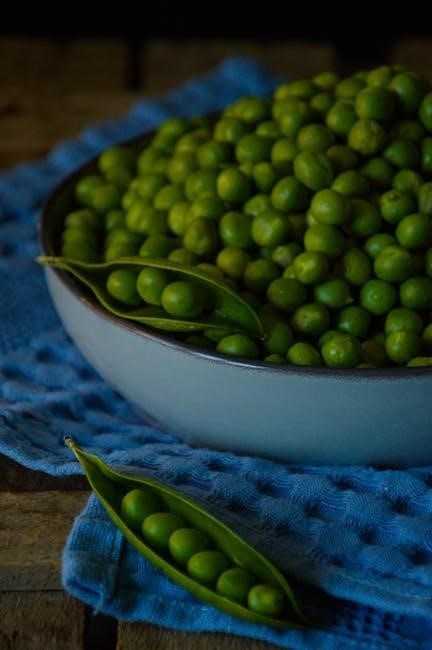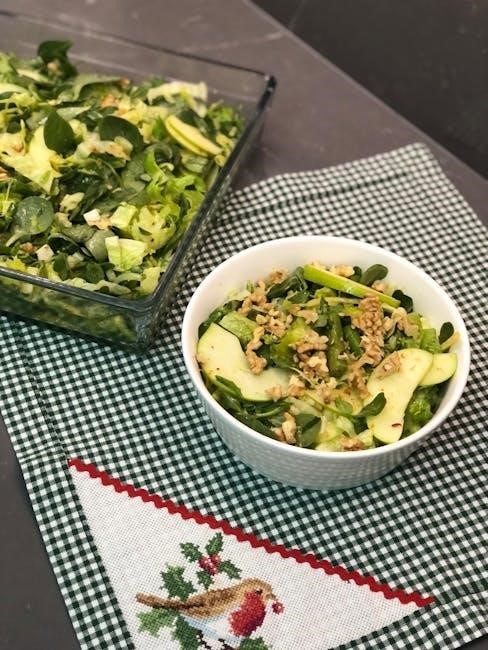The alkaline diet focuses on consuming foods that promote a balanced body pH, emphasizing alkaline-forming foods like vegetables, fruits, and healthy fats to support overall well-being.
1.1 What is the Alkaline Diet?
The alkaline diet is a dietary approach that focuses on consuming foods that promote a balanced body pH. It categorizes foods as either alkaline or acidic based on their effect on the body after digestion. The diet encourages eating alkaline-forming foods, such as vegetables, fruits, nuts, and seeds, while minimizing acidic foods like meat, dairy, and processed items. The goal is to support the body’s natural pH balance, which advocates believe may improve health and reduce disease risk. While not directly changing blood pH, the diet aims to optimize overall well-being through nutrient-rich choices.
1.2 Benefits of the Alkaline Diet
The alkaline diet is believed to offer numerous health benefits, including improved digestion, increased energy levels, and enhanced nutrient absorption. By focusing on alkaline-forming foods, it may help reduce inflammation and support immune function. Advocates suggest it could lower the risk of chronic diseases like osteoporosis and diabetes. Additionally, the diet promotes a reduction in processed foods and added sugars, which are linked to various health issues. Many followers report improved overall well-being, though scientific evidence supporting all claims remains limited. It is often seen as a holistic approach to maintaining a balanced and healthy lifestyle.

Foods to Eat on the Alkaline Diet
The alkaline diet emphasizes alkaline-forming foods like vegetables, fruits, nuts, seeds, and healthy fats. These foods help maintain a balanced pH and promote overall well-being.
2.1 Alkaline-Forming Vegetables
Alkaline-forming vegetables are central to the alkaline diet, helping to balance the body’s pH levels. Leafy greens like kale, spinach, and lettuce are highly alkaline and rich in nutrients. Broccoli, Brussels sprouts, and asparagus are also excellent choices, promoting alkalinity. Root vegetables such as beets and radishes, along with cucumbers and bell peppers, contribute to a balanced diet. These vegetables are versatile and can be enjoyed raw, roasted, or in salads. Incorporating a variety of alkaline-forming vegetables ensures a strong foundation for overall health and supports the body’s natural pH regulation.
2.2 Alkaline-Forming Fruits
Alkaline-forming fruits are essential for maintaining a balanced diet and promoting a healthy pH level. Citrus fruits like lemons, limes, and grapefruits, despite their acidity, have an alkalizing effect on the body. Tropical options such as mangoes, papayas, and pineapples are also highly alkaline. Berries, including cranberries and cherries, are excellent choices, offering both flavor and health benefits. Incorporating a variety of these fruits into your meals and snacks supports detoxification and energy levels. Alkaline-forming fruits are nutrient-rich and versatile, making them a delicious addition to an alkaline lifestyle.
2.3 Nuts, Seeds, and Grains
Nuts, seeds, and grains provide essential nutrients and support an alkaline diet. Almonds, walnuts, and pumpkin seeds are highly alkaline, while chia, flax, and sunflower seeds offer omega-rich benefits. Quinoa, millet, and barley are excellent alkaline-forming grains. Incorporating these into meals adds fiber, protein, and minerals, promoting a balanced pH and overall health. Choose unsalted, raw options to maximize their alkalizing effects and avoid processed varieties. These foods are versatile and can be added to salads, smoothies, or eaten as snacks for sustained energy and wellness.
2.4 Healthy Fats and Oils
Healthy fats and oils are crucial for an alkaline diet, offering essential nutrients and promoting vitality. Avocados, olive oil, coconut oil, flaxseed oil, and sesame oil are excellent choices, rich in omega-3 fatty acids and antioxidants. These fats support heart health, reduce inflammation, and aid digestion. Use them in dressings, cooking, or as dips for vegetables. Opt for cold-pressed, unrefined oils to retain their alkaline properties. Incorporating these fats into meals enhances flavor and provides sustained energy, making them a valuable component of an alkaline lifestyle.

Foods to Avoid on the Alkaline Diet
Eliminate processed foods, sugary snacks, red meat, dairy, and alcohol, as they promote acidity and inflammation, hindering the body’s alkaline balance.

3.1 Acid-Forming Foods
Acid-forming foods, such as red meat, poultry, dairy, and processed snacks, can disrupt the body’s pH balance by increasing acidity. These foods often contain high levels of sulfur, phosphorus, and animal protein, which the body converts into acid during digestion. Regular consumption of acid-forming foods can lead to inflammation and strain on the body’s natural pH-regulating mechanisms. Examples include beef, pork, eggs, cheese, and refined sugars. Avoiding these foods is crucial for maintaining an alkaline diet and promoting overall health. By reducing acid-forming foods, individuals can better support their body’s natural balance and improve long-term well-being.
3.2 Processed and Sugary Foods
Processed and sugary foods are highly acidic and detrimental to the alkaline diet. They include items like white bread, pastries, candies, and sweetened beverages. These foods are often stripped of nutrients and high in artificial additives, leading to an acidic environment in the body. Consuming such foods regularly can cause energy crashes, inflammation, and an increased risk of chronic diseases. To maintain an alkaline balance, it’s essential to limit or eliminate these foods from your diet and opt for whole, nutrient-rich alternatives instead. This supports overall health and aligns with the principles of the alkaline diet.

Creating an Alkaline Diet Chart
Creating an alkaline diet chart is essential for organizing your meals. It categorizes foods by their pH levels, helping you make informed choices to maintain a healthy balance easily.
4.1 Understanding pH Levels in Foods
Understanding pH levels in foods is crucial for the alkaline diet. Foods are classified as alkaline or acidic based on their pH value, with alkaline foods having a pH greater than 7. These foods, such as vegetables, fruits, and nuts, help maintain the body’s natural balance. Acidic foods, like meats and processed items, can lower the body’s pH. A chart categorizes foods from highly alkaline to highly acidic, guiding dietary choices. This system simplifies meal planning, ensuring a balanced intake of nutrients and promoting overall health by reducing acidity and fostering an alkaline environment in the body.
4.2 Sample Alkaline Diet Chart
A sample alkaline diet chart categorizes foods based on their pH levels, from highly alkaline to highly acidic. Alkaline-forming foods include green vegetables like kale, spinach, and broccoli, along with fruits such as lemons, limes, and grapefruits. Nuts, seeds, and healthy fats like almonds, flaxseeds, and olive oil are also alkaline-promoting. Grains like quinoa and millet are moderately alkaline. Acidic foods, such as meats, dairy, and processed items, are minimized. This chart serves as a practical guide for meal planning, helping individuals make informed choices to maintain a balanced diet and support overall health.

Meal Planning and Recipes
Plan balanced meals with alkaline-rich foods like green smoothies, vegetable stir-fries, and salads. Incorporate recipes using kale, spinach, almonds, and olive oil for delicious, health-promoting dishes daily.
5.1 Breakfast Ideas
Start your day with alkaline-rich breakfast options like green smoothies made with spinach, kale, and almond milk. Enjoy chia pudding with fresh berries or avocado toast on whole-grain bread. Incorporate alkaline-forming fruits such as citrus or apples into your meals. Try a vegetable omelette with bell peppers and onions for a nutrient-packed start. Smoothie bowls with granola and nuts like almonds or flaxseeds are also excellent choices. These options provide essential vitamins and minerals while promoting a balanced pH level, setting a positive tone for the rest of your day.
5.2 Lunch and Dinner Options
For lunch and dinner, focus on alkaline-forming vegetables like broccoli, Brussels sprouts, and kale, paired with healthy fats such as olive oil or avocado. Grilled or roasted vegetable dishes with quinoa or brown rice make balanced meals; Incorporate fresh salads with mixed greens, cucumbers, and bell peppers, dressed with lemon juice or olive oil. Try alkaline-rich wraps using collard green leaves as wraps, filled with hummus and veggies. Stir-fries with alkaline vegetables and tofu, seasoned with herbs, are also ideal. These meals provide sustained energy and support overall health while maintaining pH balance.
5.3 Healthy Snacks and Desserts
Healthy snacks and desserts on the alkaline diet include fresh fruits like berries, citrus, and apples, which are naturally alkaline. Sliced cucumbers, carrots, and bell peppers with hummus make great snacks. For desserts, opt for fruit salads, sorbets, or smoothies made with alkaline fruits. Dark chocolate with at least 70% cocoa is also a treat option. Avoid processed sugars and dairy, instead using natural sweeteners like dates or honey. These choices promote pH balance while satisfying cravings for something sweet and indulgent.

Scientific Basis of the Alkaline Diet
The alkaline diet is rooted in the idea that certain foods influence the body’s pH levels, promoting health by reducing acidity. The body naturally regulates its pH balance, but adhering to an alkaline diet may help maintain optimal health and reduce disease risk. Scientific debates exist, but proponents argue that alkaline-forming foods support bodily functions and overall well-being; Experts recommend consulting a healthcare professional before starting this diet.
6.1 How the Body Regulates pH Levels
The human body maintains a slightly alkaline pH, typically around 7.35-7.45, through a complex regulatory system. The kidneys excrete excess acids, while the lungs expel carbon dioxide, a byproduct of metabolism. Buffers like bicarbonate help neutralize acidity, ensuring homeostasis. Despite dietary influences, the body tightly controls its internal pH, as drastic imbalances can be life-threatening. While the alkaline diet suggests eating alkaline-forming foods to support this balance, the body’s mechanisms are highly efficient and maintain pH independently of diet. Understanding this physiology is key to grasping the diet’s principles and its potential effects on health.
6.2 Debates and Criticisms
The alkaline diet has sparked significant debate in the scientific community. Critics argue that the diet’s premise lacks robust evidence, as the body’s pH levels are tightly regulated and not significantly influenced by diet. Many experts question the diet’s claim that it can prevent chronic diseases, citing a lack of long-term studies. Additionally, the diet’s emphasis on restricting certain food groups has raised concerns about potential nutrient deficiencies. While some people report improved health outcomes, others view the diet as overly restrictive and unnecessary. The scientific consensus remains skeptical, highlighting the need for further research to validate its benefits.

Practical Tips for Following the Alkaline Diet
Start with gradual changes, use an alkaline diet chart for guidance, and incorporate alkaline-rich foods like leafy greens and citrus fruits. Stay hydrated and avoid processed foods.
7.1 Gradual Transition to an Alkaline Diet

Starting an alkaline diet doesn’t have to be overwhelming. Begin by slowly replacing acidic foods with alkaline-forming options. Use an alkaline diet chart to guide your choices.
Start with small changes, such as swapping one acidic meal for an alkaline-rich one daily. Incorporate more vegetables, fruits, and healthy fats into your meals.
Gradually reduce intake of processed foods, sugars, and meats. Track your progress and adjust as needed. Staying hydrated with alkaline water can also support the transition.
Remember, consistency is key. A gradual shift allows your body to adapt, making the diet more sustainable long-term.
7.2 Using Alkaline Diet Charts for Guidance
An alkaline diet chart is a valuable tool for planning meals and ensuring you’re making alkaline-forming choices. These charts categorize foods into alkaline, neutral, or acidic, helping you balance your intake.
Print the chart and refer to it daily to guide your shopping and cooking. Highlight or circle foods you enjoy to create a personalized plan.
Tracking your progress with the chart can help you stay motivated and maintain consistency. Use it to explore new recipes and gradually incorporate more alkaline options into your routine for optimal health benefits.
